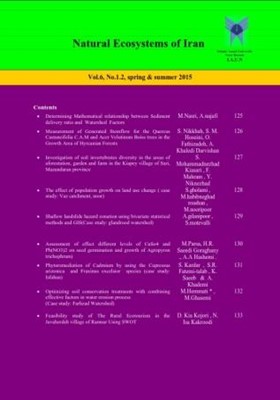Shallow landslide hazard zonation using bivariate statistical methods and GIS(Case study: glandrood watershed)
Subject Areas : forest
ali gilanipoor
1
,
sadroddin motevalli
2
![]()
1 - کارشناسی ارشد جغرافیا- دانشگاه آزاد اسلامی واحد نور
2 - دانشیار گروه جغرافیا دانشگاه آزاد اسلامی واحد نور
Keywords: GIS, landslide index, Alborz, Shallow landslide, certainty factor, northern uplands, Noor,
Abstract :
Abstract Nowadays, landslides are treats for terrestrial ecosystems and their living organisms and they are present in the study area. The aim of current research is obtaining the most important effective factors on shallow landslide occurrence in northern Alborz (Noor County). In the first place, landslide locations were determined by field monitoring and the inventory map of landslides was then prepared. Subsequently, the most effective factors on the landslide incident from 16 data layers, such as biotic and abiotic factors, were derived into ArcGIS 9.3 software. Three models including Landslide Index, Frequency ratio and Certainty Factor were considered to provide the landslide susceptibility map. ROC curve was used to evaluate the models. Results showed that hydrologic elements such as of soil humidity, soil infiltrability, and soil texture along have the highest amount of relationship with the occurrence of shallow landslides in the study region. The results of assessment of model analysis also showed that the shallow landslide zonation map obtained from frequency ratio mode is more accurate one.
References
1. Althuwaynee, O., B. Pradhan, and S. Lee, 2012. Application of an evidential belief function model in landslide susceptibility mapping, Computers & Geosciences 44: 120–135.
2. Bayati, M. 2006. The slope of determine potential susceptibility to landslides in mountainous basins, Using determine special agent, Human Sciences MODARES journal, 53(4):29-55
3. Binaghi, E., Luzi, L., Madella, P., Pergalani F., Rampini, A., 1998. Slope instability zonation: a comparison between certainty factor and fuzzy dempster.shafer approaches, Natural Hazards, 17: 77-97.
4. Bui, D. T., B. Pradhan, O. Lofman, I. Revhaug, and O. Dick, 2012. Landslide susceptibility assessment in the HoaBinh province of Vietnam: A comparison of the Levenberg–Marquardt and Bayesian regularized neural networks, Geomorphology, 171-172(1): 12-29.
5. Choi, J., H. Oh, H. Lee, C. Lee, and S. Lee, 2012. Combining landslide susceptibility maps obtained from frequency ratio, logistic regression, and artificial neural network models using ASTER images and GIS, Engineering Geology. 124(1): 12–23.
6. Crosta, G.B., 2004. Introduction to the special issue on rainfall-triggered landslides and debris flows. Engineering Geology 73: 191–192.
7. Dadson, S., Hovius, N., Chen, H., Dade, W.B., Lin, J.C., Hsu, M.L., Lin, C.W., Horng, M.J., Chen, T.C., Miliman, J., Stark, C.P., 2004. Earthquake-triggered increase in sediment delivery from an active mountain belt. Geology 32: 373–376.
8. Ercanoglu. M., Candan. G. P., 2004. Use of fuzzy relation to produce landslide susceptibility map of a landslide prone area(West Black Sea Region, Turkey), Engineering Geology 75: 229-250.
9. Heshmati, M., Shamshuddin, J., Majid, N. M., Ghaituri, M. 2011. Factors affecting
landslides occurrence in agro-ecological zones in the Merek catchment, Iran, Journal of Arid Environments. 75(11): 1072-1082.
10. Ingram, R. L. 1953. Fissility of mudrocks: Geological Society of America, Bulletin 64: 869–878.
11. Jaada, M. 2009. Landslides Hazard Analysis Using Frequency Ratio Model. Universiti Putra Malaysia, Serdang. 181 pp.
12. Keefer, D.K. 1994. The importance of earthquake-induced landslides to long-term slope erosion and slope-failure hazards in seismically active regions. Geology 10:265–284.
13. Kitutu, M.G., Muwanga, A., Poesen, J., Deckers, J.A. 2009. Influence of soil properties on landslide occurrences in Bududa district, Eastern Uganda, African Journal of Agriculture Research, 4(7): 611-620.
14. Marjanovic, M., M.Kovacevic, B. Bajat, and V. Vozenilek. 2011. Landslide susceptibility assessment using SVM machine learning algorithm, Engineering Geology. 123: 225-234.
15. Mohammadi, M., H. Moradi, S. Feiznia, and H. Porghasemi. 2010. Comparison of the Efficiency of Certainty Factor, Information Value and AHP Models in Landslide Hazard Zonation (Case study: Part of Haraz Watershed), Iranian Journal of Natural Resources. 62(4): 539-551.
16. Oh, H.J. and B., Pradhan. 2011. Application of a neuro-fuzzy model to landslide-susceptibility mapping for shallow landslides in a tropical hilly area, Computers and Geosciences. 37: 1264-1276.
17. Ohlmacher, G.C. Davis, J.C. 2003. Using multiple logistic regression and GIS
technology to predict landslide hazard in Northeast Kansas, USA, Engineering
Geology, 69: 331-343.
18. Rautela, P., Lakhera, R.C. 2000. Landslide risk analysis between Giri and Ton Rivers in Himalaya (India). International Journal of Applied Earth Observation and Geoinformation 2: 153–160.
19. Van Westen, C. J. 1993. Application of Geographic Information Systems to Landslide Hazard Zonation, Ph-D Dissertation Technical University Delft. ITC Publication Number 15, ITC, Enschede, The Netherlands, 245 pp.
20. Yalcin, A. 2011. A geotechnical study on the landslides in the Trabzon Province, NE, Turkey, Applied clay science, 52: 11-29.
21. Zare, M., H.R., Pourghasemi, M., Vafakhah, , B., Pradhan. 2012. Landslide susceptibility mapping at Vaz Watershed (Iran) using an artificial neural network model: a comparison between multilayer perceptron (MLP) and radial basic function (RBF) algorithms. Arabian Journal of Geosciences. http:// dx.doi.org/10.1007/s12517-012-0610-x.


